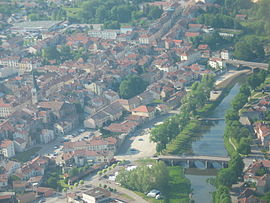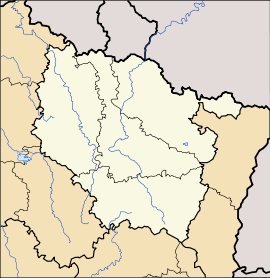- Mirecourt
-
Mirecourt

Administration Country France Region Lorraine Department Vosges Arrondissement Neufchâteau Canton Mirecourt Intercommunality Association of Mirecourt Country communes Mayor Maria Rouyer
(2001–2008–2014)Statistics Elevation 261–378 m (856–1,240 ft)
(avg. 285 m/935 ft)Land area1 12.12 km2 (4.68 sq mi) Population2 6,415 (2006) - Density 529 /km2 (1,370 /sq mi) INSEE/Postal code 88304/ 88500 1 French Land Register data, which excludes lakes, ponds, glaciers > 1 km² (0.386 sq mi or 247 acres) and river estuaries. 2 Population without double counting: residents of multiple communes (e.g., students and military personnel) only counted once. Coordinates: 48°17′00″N 6°08′00″E / 48.2833°N 06.1333°E
Mirecourt is a commune in the Vosges department in Lorraine in northeastern France. Mirecourt is known for lace-making and the manufacture of musical instruments, particularly those of the violin family. Inhabitant are called Mirecurtiens.
Contents
Geography
Mirecourt is the administrative capital of a canton positioned in the Xantois district at the heart of the Vosges plain, at the confluence of the River Madon with the Arol Valley. Most of the town is laid out on the west side of the Madon on a succession of levels. Visitors are attracted by the richness of the town's architecture and by the natural advantages of the site.
Mirecourt is also at the heart of a road crossing, 24 kilomaters (15 miles) from Vittel, 35 kilometres (22 mi) from Épinal to the east-south-est, 40 kilometres (25 mi) from Neufchâteau and 48 kilometres (30 mi) from Nancy. For much of the twentieth century Mirecourt was a staging post on the RN66, a major road towards Paris. Following improvements to the autoroute network towards the end of the twentieth century, the nearest major routes to Paris are now, the A31 autoroute and the RN57 respectively some fifteen kilometres (9 miles) to the west and to the east. The RN 66 has been correspondingly declassified: elements of the economic focus that once followed the old route nationale has followed the traffic away to the newer routes: in the final forty years of the twentieth century the registered population declined by around 25%, though the level appears subsequently to have plateaued at around 6,400.
Economy
Artisanal
An unusual feature of Mirecourt is the extent to which the local economy continues to be underpinned by the same skilled crafts that have supported the local community for centuries. Both musical instrument and lace making bring significant amounts of wealth and employment to twenty-first century Mirecourt.
String instruments
Mirecourt's tradition of luthierie seems to date back to the end of the sixteenth century and the travels of the Dukes of Lorraine and their retinues to Italy. It was particularly in Mirecourt that the business of making stringed instruments took off, with 43 luthiers in 1635, and the business continued to grow into the twentieth century, by when it was claimed that Mirecourt was producing more than 80,000 instruments annually. This is frequently a family business which can grow into a dynastic one: numbered among Mirecourt's Lutherie dynasties have been the Derazey, Aldric, Lupot, Langonet, Gand, Bernard, Jacquot, Nicolas, Mougenot, Charotte, Apparut, Hilaire, Collin, Laberte, Magnié, Peccate, Bazin, Ouchard and Vuillaume families including, most famously, Jean-Baptiste Vuillaume 1798 - 1875.
By 1925 the craft was organised into 18 workshops and 4 factories employing 680 workers. The economic and political hardships of the mid-twentieth century coincided with the disappearance of the workshops. However, the creation in the 1970s at Mirecourt of the National School of Lutherie (École nationale de lutherie) [1] signalled a renaissance which has endured into the present century. Notably, Jean-Jacques Pages has produced outstanding instruments by copying famous eighteenth century models by the likes of Stradivarius and Amati. The Gérome brothers, now retired from making guitars and mandolins, have had their work endorsed by Georges Brassens who has purchased one off their guitars.
The industry is celebrated by the presence in Mirecourt of a municipal Lutherie Museum.
Lace
Lace making is believed to have been introduced to Lorraine only in the sixteenth century, when the art arrived from Lombardy with the violin makers sponsored by the Dukes of Lorraine. Peter Fourier, the priest at nearby Mattaincourt, who would subsequently become a saint in recognition of his energetic work resisting the Protestant currents from east of the River Rhine, established the Convent of Notre-Dame (Our Lady) and there encouraged instruction in lace making both at the school which was operated by the Sisters and at the orphanage. The project was a great success with daughters of rich families and with girls of the peasant class. By 1790 lace makers from Mirecourt were supplying merchants from abroad, and despite the political and social turbulence of the early nineteenth century, the lace business continued to flourish and grow, with the middle of the nineteenth century a golden age. Nevertheless, by the middle of the twentieth century lace had fallen out of favour and the industry locally was much diminished. It has nevertheless survived, and today, supported by 140 participants, the Mirecourt lace business has recovered some of its international reputation. Lace making courses and permanent exhibitions of the craft remain a feature of the town.
Public and service sectors
The Vosges psychiatric hospital (le centre hospitalier psychiatrique/CHS) remains the largest employer in the commune of Mirecourt, with over 1,000 salaried staff on the payroll.
The commune's territory also contains the Mirecourt-Epinal aerodrome, which is managed by the departmental Chamber of Commerce.
History
Mirecourt was founded during the first millennium. Mercuri Curtis was dedicated by the Romans to the cult of the god Mercury. Early on, the town was part of the property of the Counts of Toul.
The first surviving written record of Mirecourt dates from 960. This is the text of a donation made by a man called Urson who transferred his domain of Mirecourt (two farmsteads and environs) to the Abbey of Bouxières-aux-Dames.
The heirs to the Counts of Toul were the Dukes of Lorraine who owned the little town during the thirteenth century. An act of 1284, during the time of Duke Frederick III, confirms the annexation of Mirecourt and its lands to the Duchy of Lorraine. Mirecourt, the main town in the important Vôge Bailiwick, was above all a great trading centre. A European focus of economic and commercial energy during the sixteenth century was Lombardy from where the Dukes of Lorraine introduced to Mirecourt the manufacture of string instruments, a tradition which continues to flourish. At the same time Mirecourt became a centre of organ building.
The last Duke of Lorraine to rule the territory was the former Polish king, Stanisław Leszczyński. He died early in 1766 and Lorraine passed to his grandson, by now King of France. In this way the long struggle to control the territories between France and the Rhine was settled in a manner which no doubt would have pleased Le Grand Monarque. Ten years later, in 1776, the office of Lieutenant-General of the Bailiwick was sold to the young François de Neufchâteau.
Under the secular regime established in the wake of the French Revolution, Mirecourt became the administrative centre of the district and then of the entire arrondissement. This last distinction was lost in 1926, and today Mirecourt falls within the Arrondissement of Neufchâteau.
One of the first boys' primary schools in France was founded at Mirecourt in 1828.
Twin towns
Personalities
- Charles Jean Baptiste Collin-Mezin, French violin maker (1841-1923)
- Louis Buffet, Statesman (1818 - 1898)
- Peter Fourier, Scholar, saint and Counter reformation campaigner (1565 - 1640)
- Jean-Marie Georgeot, Biblical scholar (born 1923)
- Jack Lang, Socialist Party politician (born 1939)
- Jérôme Thibouville-Lamy (Most important French mass production musical instrument maker, had his factory there from 1860)
- Jean-Baptiste Vuillaume, French violin maker (1798-1875)
- Nicolas François Vuillaume, French violin maker (1802-1876)
- Emile Auguste Ouchard (1900-1969), bow maker
- Bernard Ouchard (1925-1979), bow maker
See also
References
External links
Categories:- Communes of Vosges
Wikimedia Foundation. 2010.


